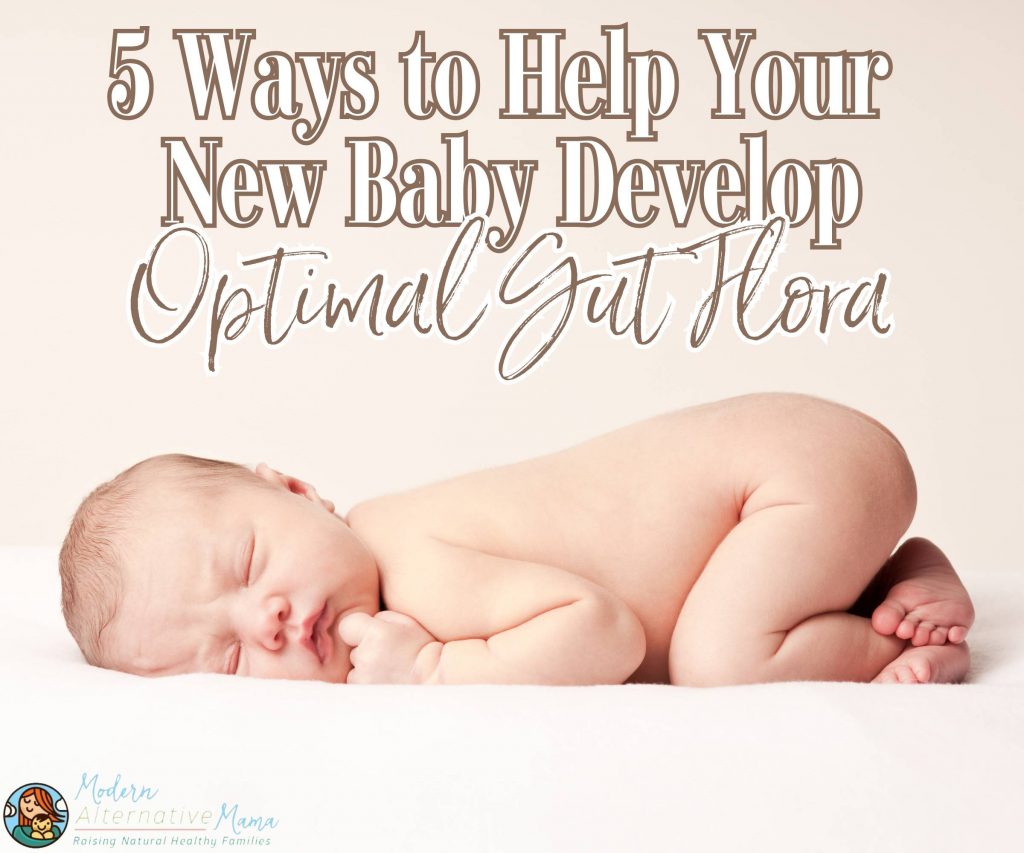Gut flora and its implications on health are a little bit of an obsession for me.
If you’ve been paying attention to the research that’s come out in the last few years, it’s easy to see why. Just about everything about who we are and how healthy we are is rooted in our gut. Our flora can determine if we’re fit or obese; if we have depression or anxiety or not; if we get sick; if we have chronic or autoimmune illnesses; if we develop autism; and so much more!
This is a good overview of the importance of the topic.
So — clearly it’s important. We want our babies to have optimal gut flora if at all possible. Those early days and weeks after birth are critical for laying the groundwork for healthy flora.
At this point in time, we know several strains of bacteria that appear to be “normal” in newborns, children, and adults. We know that certain strains of bacteria appear to be specifically beneficial. We don’t, however, have any idea, yet, what “typical” or optimal” gut flora looks like in children. So, we’re going based on biological norms and what we do know about beneficial strains in order to establish this. It’ll probably be several years before we learn what is optimal through clinical research — assuming we ever do. There are too many negative impacts on normal gut flora (antibiotic use, unhealthy food, formula feeding, early solids, etc.) for researchers to gather any large pool of “healthy” children to study long-term.
We’re basically going on the assumption that most of us have disturbed gut flora, and hoping for better for our children. Thankfully, that’s possible, because research shows that neonatal gut flora is largely influenced by environment, not genetics!
With that, let’s dive in.
5 Ways to Help Your New Baby Develop Optimal Gut Flora
1. Aim for a Natural Birth
Whenever possible, birth should occur:
- Spontaneously (not induced)
- Vaginally
- Without any medications
After birth, there should be immediate skin-to-skin contact between mom and baby, with as little interference as possible. This means no towels or blankets (especially ones in hospitals with foreign germs), no nurses or doctors or other non-family-members touching the baby, and certainly no removing the baby from mom’s arms in the first hour. Contact should be undisturbed, baby should be encouraged to move to the breast and latch on when ready, and nurse for as long as desired. Many babies will do the “breast crawl” at this time if left alone. The cord should not be cut until at least 2 – 3 minutes after birth, once it has stopped pulsing; longer is even better (many wait until the first hour is over, so as not to disturb mom and baby at this critical time).
Now. Obviously, this isn’t always possible. If you are birthing in a hospital, you can bring some of your own receiving blankets from home and ask that they are used instead of the hospital blankets. If a c-section is necessary, skin-to-skin time with Dad instead is a good option, or if you are doing well enough, placing the baby on your chest (with help) and encouraging breastfeeding is possible. Look up “gentle cesarean.” Try to insist on skin-to-skin time and that any exams be done at your bedside with minimal touching from doctors and nurses. Basically, you do whatever part of this works for you.
Even if everything goes wrong (or different) during birth, there’s still a lot you can do in those first weeks.
2. Limit Who Touches Baby
Baby’s gut flora represents environmental influences, including who touches the baby regularly in these first weeks. If you birth in a hospital, leave as soon as you and baby are cleared to do so. While in the hospital, make sure that you change baby’s diapers, hold baby, and do all the baby care instead of the nurses. Room-in with baby. If you are unable to do so, have Dad stay with the baby, do skin-to-skin time with baby, change baby’s diapers, etc. instead. Failing that, see if another family member or close friend can come and help.
Once at home, limit the visitors that come in — or ask them to help with older kids, chores, etc. and stay away from baby (just for a couple weeks!). Of course, it’s your choice if you want extended family members to come in and hold baby.
Practice lots of skin-to-skin time with your baby, and encourage other immediate family members to do it, too. Just be cautious about anyone outside the family touching the baby too much for about 2 – 3 weeks, and try to stay home during that time. If you need to go out, wrap your baby up against you and don’t let others touch. It’s impossible to know if someone else’s flora is healthy, and baby is meant to get their initial flora from mom. Keep your baby close.
3. Breastfeed Early and Often
Breastfeeding is a huge part of developing gut flora. It contains actual probiotics, growth factors, immune modulators, and more. It functions as your baby’s immune system and matures baby’s gut for several months. Breastfeed baby as often as needed (which could be every 30 minutes at some times; others more like every 2 – 3 hours). Start immediately after birth and keep going. One of mine nursed every 10 minutes for 12 straight hours on his second day of life (and settled back to about every 2 hours once my milk came in). This is simply the best thing you can do.
If you are unable to breastfeed, seek donor milk if possible. If you are unable to do that, choose a safe formula that contains infant probiotics, or add an infant probiotic formula to the formula.
4. Don’t Bathe the Baby
For real — don’t wipe the baby too roughly after birth (don’t remove the vernix), and don’t bathe the baby! Delay that first bath for at least a week, possibly longer. Rub vernix into the skin instead of wiping it off. All of the fluids and such that are on baby at birth actually help boost the immune system, so they are necessary! This, most anyone can do even if the other stuff doesn’t go as planned.
5. Take a Probiotic Supplement
This is also something everyone can do! Research shows that probiotics are passed from mom to baby both during pregnancy and breastfeeding. Even if your gut flora isn’t optimal, taking a probiotic supplement can ensure that your baby is getting the probiotics that they need. Choose one that specifically contains strains of bifidobacteria — specifically b. infantis and b. longum. Look for a supplement that contains many different strains.
These are the top 5 things you can do to help your baby have optimal gut flora. Obviously, life isn’t perfect and you may not be able to do all of them. Those early weeks and months are pretty critical, so do everything you can to protect baby during that time.
A bonus 6th way you can help — delay the introduction of solids. Solids should be introduced no earlier than six months of age, and 8 – 10 months is fine for many babies. When you do introduce solids, don’t introduce grains at all until well past a year. Advice on when/how to introduce solids is really a separate post. For now, just know — not before 6 months. This includes no rice cereal in a bottle.








We certainly aim for all of these things, too. For this Baby, we’re already planning to do a “lying in” period for about 2 weeks before we have family or friends over to meet the baby, at which point, we’ll have a coming home party.
Even if I didn’t have an inkling about gut flora, this just feels right. And it’s always nice to know there’s so research backing up some of my more natural minded feelings and thoughts! 🙂
Why is it safer for people to touch the baby the closer they are related to it?
The bacteria introduced in the first few weeks of life aren’t necessarily the flora that will be a permanent part of the child’s flora. Our bacterial flora can change and often does. Skin to skin when baby is first born is definitely important, but it is rather ridiculous and unnecessary to not let even a doctor or nurse touch or change your baby, provided they have thoroughly washed and sanitized their hands first.
Another thing, naming conventions state that the genus be capitalize whereas the species is all lowercase, all in italics. E.g.: /B. infantis/
Love these tips! I am planning a 2VBAC in Oct. and will definitely be implementing the golden hour and delayed bathing. My oldest has a very sensitive immune system/gut and I know it is because of my diet during pregnancy and the fact that he had a c-section birth. We have been working on it, did GAPS for a while and we mostly eat a grain free diet and have seen great improvement since then. He is also on probiotics and cod liver oil. I’m optimistic that in a couple years we will be able to reverse the damage anf have him as healthy as the rest of the family.
I found this all really interesting as my 10 weeks old has always seemed uncomfortable and straining with gut complaints. Unfortunately most of these suggestions couldn’t apply to my situation. Waters broke at 32 weeks so was on antibiotics for 2 weeks before emergency c section, baby taken straight to special care and had formula mostly for first couple of days, he then received my milk by tube. 2 weeks later he received another course of antibiotics. Since then he also had a hernia operation. He is exclusively breastfed but I have now cut out wheat, dairy and gluten from my diet to see if it helps his tummy complaints. I guess my question is how can I restore positive gut flora or help him from now on? I feel helpless but all these circumstances were unavoidable and far from ideal.
Hi Sarah,
Are you taking a probiotic? If not, I would start there! Also eliminating any sugar (except honey) if you haven’t. I use this probiotic (affiliate link): http://amzn.to/1TZMVSf It seems to help both me and my baby (spits up less often). There are also powders made for infants from Klaire Labs, and in his case I might try that, too, since he dealt with a lot of unfortunate circumstances. I hope that helps!
[…] been talking a lot about gut flora, especially in children. A couple weeks ago, I wrote “5 Ways to Help Your New Baby Develop Optimal Gut Flora.” That’s a great read, especially if you have a young baby (who hasn’t yet […]
An Asian friend of mine told me how the Japanese take their babies to B&B animal farms within the first year of the baby’s life to boost their immune system. You may not want to do this with a new baby, but it is certainly something to think about later on. The Amish have great immune systems party due to their close contact with animals. We can’t all live on a farm but having house pets will also help a child’s immune system.
Perfect article about this topic I ever seen before.It’s the best.Love this blog,because of your brilliant writing.Natual birth and breastfeeding both are useful for mamma and kids..
[…] If you’re still expecting, congratulations! Check out these tips for promoting optimal gut health in your newborn. […]
[…] If you’re interested in learning more about this issue, check out 5 Ways to Help Your Infant Develop Optimal Gut Flora. […]